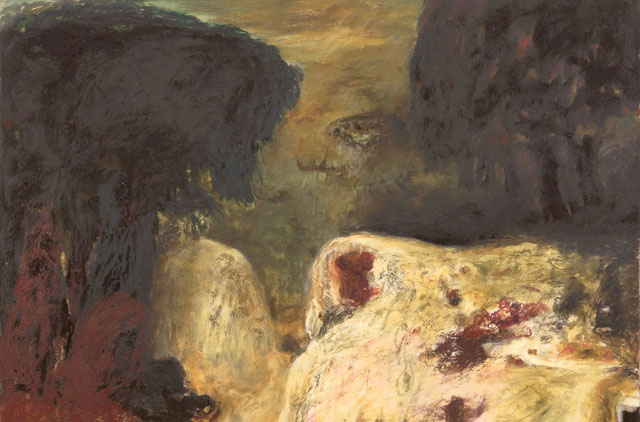
Ziad Dalloul is a pioneer of contemporary Syrian art and is recognised as a leading painter and printmaker in the Arab world. The Paris-based artist's first solo exhibition in the UAE, titled Celebrations of the Absent, features a series of large-scale oil paintings, works on paper and limited-edition etchings.
The etchings on display are from The Book of Cities, Dalloul's famous collaboration with Syrian poet Adonis, where he created visual interpretations of Adonis's poems about important cities around the world. The oil paintings are a continuation of his exploration of the relationship between man and nature.
In his paintings, the artist juxtaposes domestic scenes, such as tables set for a feast, with flowing waterfalls and lush greenery to create beautiful, surreal landscapes. By blurring the line between the inside and the outside, Dalloul comments on our growing distance from nature and our inner selves, and makes us think about what is missing from our urban lifestyle and environment.
"Celebrations of the Absent is not about celebrating the absence of people. Instead, the people who cannot be seen in the paintings are celebrating. Through the household objects, I have tried to impart a warm, lived-in feeling to the paintings so that you can feel the presence of the people who inhabit these interiors, despite their absence. The idea behind juxtaposing rooms and furniture with nature is to transport the exterior into the interior, making it warm and intimate and taking the interior outdoors to connect it with nature. I want viewers to think about this philosophical process because I believe that, rather than providing answers, the role of art is to make us question," Dalloul says.
The artist's use of colour and play of light and shadow draw viewers deep into his intriguing landscapes. And although there are no people in the paintings, one can sense strong emotions in the canvases.
"All art should be emotional. It should trigger something — first in the artist and then in the audience — because only if the artist feels the emotion can he portray it in the work. To create meaningful work, an artist must contemplate existential questions about who we are, why we are here and where we are going. And this process is what triggers the emotions that can be felt by viewers," Dalloul explains.
The tables in his paintings are laden with colourful flowers and fruits, such as pomegranates and figs, which are often used symbolically in oriental art. But Dalloul insists that these have no symbolic significance in his work.
"I refuse to use any kind of symbolism. As you can see, there are no cars, buildings or anything technological in my paintings. I go back to nature because that is what makes a person human. The table is there because it is an important element of our daily life. And all the things on the table have come from nature. I am not interested in urbanisation and just want to be close to the real world," he says.
This feeling is also expressed through the interesting ways the different elements in the paintings merge together. The tablecloth looks like a waterfall and so does a scarf draped on the back of a chair. And what appears like a cliff could also be a bed. But one can also see walls standing between the interiors and exteriors in the paintings.
"My work is about integration with nature, and everything in my painting must become part of the environment. I want to say that there are no distinct lines of separation between us and nature, and even a table is part of nature. The walls in my paintings represent a dialogue between the interior and the exterior, which is missing in our lives today. So their presence reminds us of what is absent," the artist says.
Dalloul is proud of the fact that his paintings have a romantic, classical look. "I strongly believe that to create contemporary art, you need to first understand the history of art. This thought is always in my mind and I make sure that my work respects the history of modern painting. But my palette, concepts, techniques and art practice are contemporary," he says.
He is also happy that his landscapes are viewed as oriental by European audiences and as European by viewers in this region. "Maybe some elements in the paintings come subconsciously from my childhood memories of the Syrian countryside. But these are landscapes that have been created from my imagination.
"I believe that art should not be a replica of the real world; it should be an imaginary, parallel world that makes us aspire to become better human beings and to make the world a better place. In today's world it feels as if everything that is beautiful — nature, literature, poetry or philosophy — is being attacked. So, essentially, my work is about protecting beauty. We have become disconnected from nature, and it is important to make people aware of what is slipping away from us and needs to be protected," he says.
Celebrations of the Absent will run at Green Art Gallery until January 5, 2012.












